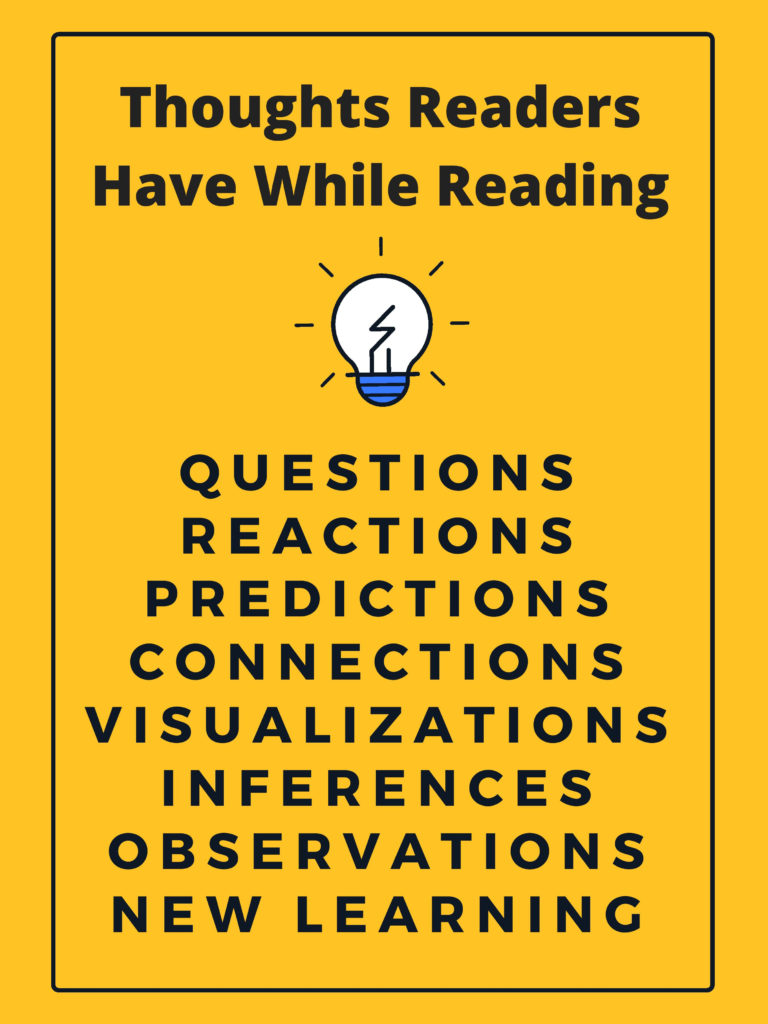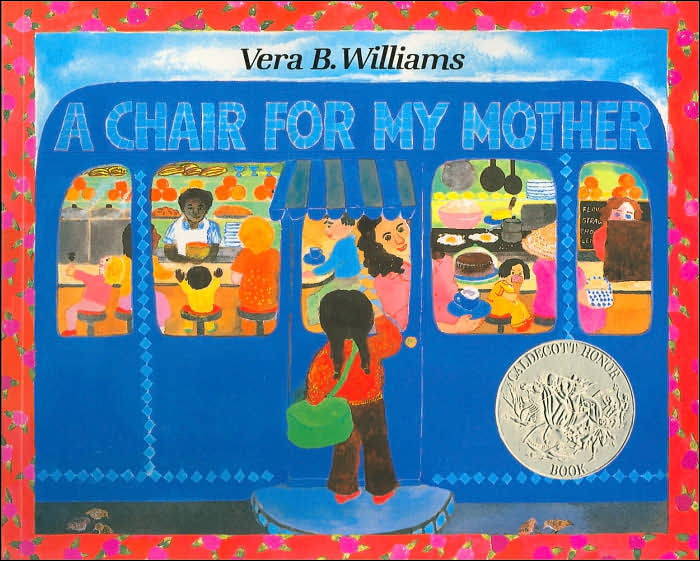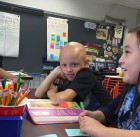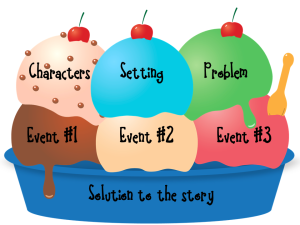Viewing: narrative elements
October 13, 2021
What have we been working on in reading?
In fourth grade, we kick off the year with a mini-unit focusing on the habits of reading. This includes how to choose a just-right book, why readers abandon books, how to discuss books, activities to build students’ reading stamina, and so much more. I want students to develop a life-long love of reading and to look at reading as an enjoyable hobby, not just as a requirement tied to school. We launched the year with these activities in order to provide students with a foundation for all of our other reading activities throughout the year. You’ll hear more from me, in the coming weeks, about your child’s “just right” reading level and how you can use that information to support his/her continued growth as a reader.

One of the best ways to grow as a reader is to discuss what you read. Throughout the year, this will be a focus. I want students to learn how to have conversations about what they read, beyond sharing factual information about the book and telling whether they like it or not. Over the years, I have kept track of the different kinds of thoughts readers have about their texts, and I narrowed them down to eight different categories. Listed in the graphic to the left, these ideas help us to make the idea of “Reading is Thinking” more concrete, and less of a nebulous “Gee… I’m supposed to think about… stuff… while I read!” Kids can focus their thinking in different categories, which can help to build these habits so the ideas come naturally as they grow and mature. Students are often encouraged to “stop and jot” while reading and to record some of their ideas on sticky notes, which then get placed in the book. (This is why we may go through sticky notes to quickly in class!) This can facilitate engaging discussions about books. Wondering how you can help your child? Use these eight types of thoughts to guide some of your reading discussions with your child. Rather than asking an open-ended question like “What did you think about _________?”, you can ask a more specific question using one of these eight types of thoughts. It can lead to a great conversation, especially when discussing connections.
With a lot of these foundational skills established, we’re now in the midst of our first core literacy unit. Students are learning about narrative elements (characters, settings, problems, main events, and solutions), and while these are hardly new concepts, they’re learning more sophisticated applications of these ideas. For example, where stories for younger kids have characters who are clearly “good” or “bad”, stories for upper elementary students tend to have more nuanced characters, with flawed protagonists or antagonists who still have redeeming qualities. Likewise, where stories for younger kids have a clearly defined problem and solution, stories for older children will start to have multiple problems and endings that may not solve problems as much as resolve challenges. As you read with your child, or as he or she reads independently, ask him/her questions about these different elements. (We’ve finished learning about the setting, and we’re now learning about characters. Next week, we will begin to work on identifying the problem in a story!
The start of the school year wouldn’t be complete without some reading assessments. This year, we’ve continued to use an assessment tool called aimswebPlus. aimswebPlus is an online tool that allows us to administer and score an oral reading assessment as well as reading comprehension tools. Starting this year, instead of giving students DRA assessments, we will use Benmark Assessments to help me to identify your child’s independent reading level, which will allow me to work with you to help your child to find just-right texts. Like DRAs, the Benchmark Assessments (often abbreviated as BAS) is giving individually to each student. It’s time consuming, but it’s well worth the time, as I’m getting to know your kids very well as readers.
In the next post, I’ll fill you in all about what we’re doing in writing! Enjoy your weekend!
Posted in Class Updates|By Jon Moss
October 23, 2020
Building Strong Reading Habits and Skills
In fourth grade, we kick off the year with a mini-unit focusing on the habits of reading. This includes how to choose a just-right book, why readers abandon books, how to discuss books, activities to build students’ reading stamina, and so much more. I want students to develop a life-long love of reading and to look at reading as an enjoyable hobby, not just as a requirement tied to school. We launched the year with these activities in order to provide students with a foundation for all of our other reading activities throughout the year. You’ll hear more from me, in the coming weeks, about your child’s “just right” reading level and how you can use that information to support his/her continued growth as a reader.

One of the best ways to grow as a reader is to discuss what you read. Throughout the year, this will be a focus. I want students to learn how to have conversations about what they read, beyond sharing factual information about the book and telling whether they like it or not. Over the years, I have kept track of the different kinds of thoughts readers have about their texts, and I narrowed them down to eight different categories. Listed in the graphic to the left, these ideas help us to make the idea of “Reading is Thinking” more concrete, and less of a nebulous “Gee… I’m supposed to think about… stuff… while I read!” Kids can focus their thinking in different categories, which can help to build these habits so the ideas come naturally as they grow and mature. Students are often encouraged to “stop and jot” while reading and to record some of their ideas on sticky notes, which then get placed in the book. (This is why we go through sticky notes to quickly in class!) This can facilitate engaging discussions about books. Wondering how you can help your child? Use these eight types of thoughts to guide some of your reading discussions with your child. Rather than asking an open-ended question like “What did you think about _________?”, you can ask a more specific question using one of these eight types of thoughts. It can lead to a great conversation, especially when discussing connections.
With a lot of these foundational skills established, we’re now in the midst of our first core literacy unit. Students are learning about narrative elements (characters, settings, problems, main events, and solutions), and while these are hardly new concepts, they’re learning more sophisticated applications of these ideas. For example, where stories for younger kids have characters who are clearly “good” or “bad”, stories for upper elementary students tend to have more nuanced characters, with flawed protagonists or antagonists who still have redeeming qualities. Likewise, where stories for younger kids have a clearly defined problem and solution, stories for older children will start to have multiple problems and endings that may not solve problems as much as resolve challenges. As you read with your child, or as he or she reads independently, ask him/her questions about these different elements. (We’ve finished learning about the setting, and we’re now learning about characters. Next week, we will begin to work on identifying the problem in a story!
The start of the school year wouldn’t be complete without some reading assessments. This year, we’ve started to use an assessment tool called aimswebPlus. aimswebPlus is an online tool that allows us to administer and score an oral reading assessment as well as reading comprehension tools. We are also continuing to give your students DRAs. DRAs (Developmental Reading Assessment) help me to identify your child’s independent reading level, which will allow me to work with you to help your child to find just-right texts. The process of giving DRAs (which are always given individually to students) is taking a bit longer than normal, because we (of course) couldn’t give these assessments in the springtime, so we’re doing some extra catch up. But it’s well worth the time, as I’m getting to know your kids very well as readers.
As valuable as the DRAs are, I also value getting information from reading conferences. In a reading conference, I sit with a student, invite them to read to me for a bit, and we discuss the story they’re reading. We always use whatever book they’re currently reading, so it’s a great opportunity to discuss reading interests, habits, and much more!
In the next post, I’ll fill you in all about what we’re doing in writing! Enjoy your weekend!
Posted in Class Updates|By Jon Moss
October 22, 2017
What are we reading?
Hello, families! I apologize for the long stretch since I’ve gotten to touch base with you. I try to post an update every few weeks, but it seems like things at PGS are getting busier and busier. Please know that if you’re not hearing from me for a while, it’s not a lack of interest or concern, but rather, I’m trying to tackle things that are time sensitive. Planning instruction, reviewing student work, emailing or calling families, and meeting with coworkers are all things that can push website posts to the back burner. But I will do my very best to keep on top of this as well.
 On to the updates! In reading, we have been focusing on narrative elements, which are the parts of a story. Sound repetitive? Your fourth grader has probably learned this every year since kindergarten! But each year, we get a bit more in-depth. Narrative elements are: setting, characters, problems, solutions, and main events. With this focus, we also learn about theme, summaries, and retellings. We started with a study of character traits, and this past week, we really immersed ourselves in a study of setting. Hopefully your child asked you about setting last week, because while many of us adults correctly identify setting as WHERE the story takes place, we often forget that setting is also WHEN a story takes place. To focus on character and setting, we’ve read four wonderful books: The Purple Coat is a great book about a girl who desperately wants a purple coat, instead of her usual navy coat. This was one of my most beloved books when I was young, and I’m glad to share it with the students! (I told the kids that this was my absolute favorite book, but I’ve already said that about a few different titles, so I think they’re on to me.) We searched for evidence in the text to find where and when the story took place, and we used color-coded highlighting tape to organize the evidence. In fourth grade, a big focus is not just finding textual evidence (also often referred to as textual support) to prove one’s point of view, but in choosing the most valuable examples to highlight one’s argument. In the case of The Purple Coat, there was ample evidence to show when and where the story took place, so we were able to work on how to be selective.
On to the updates! In reading, we have been focusing on narrative elements, which are the parts of a story. Sound repetitive? Your fourth grader has probably learned this every year since kindergarten! But each year, we get a bit more in-depth. Narrative elements are: setting, characters, problems, solutions, and main events. With this focus, we also learn about theme, summaries, and retellings. We started with a study of character traits, and this past week, we really immersed ourselves in a study of setting. Hopefully your child asked you about setting last week, because while many of us adults correctly identify setting as WHERE the story takes place, we often forget that setting is also WHEN a story takes place. To focus on character and setting, we’ve read four wonderful books: The Purple Coat is a great book about a girl who desperately wants a purple coat, instead of her usual navy coat. This was one of my most beloved books when I was young, and I’m glad to share it with the students! (I told the kids that this was my absolute favorite book, but I’ve already said that about a few different titles, so I think they’re on to me.) We searched for evidence in the text to find where and when the story took place, and we used color-coded highlighting tape to organize the evidence. In fourth grade, a big focus is not just finding textual evidence (also often referred to as textual support) to prove one’s point of view, but in choosing the most valuable examples to highlight one’s argument. In the case of The Purple Coat, there was ample evidence to show when and where the story took place, so we were able to work on how to be selective. 
We have also read Melissa Parkington’s Beautiful, Beautiful Hair, which, while not on my list of favorite books, is an outstanding story about a girl who wants to be known for something she does, not just for her lovely hair. This was a great means for us to focus on character traits, and as we learned more about Melissa Parkington, we were able to identify and support our opinions about her character traits.
 You may have seen The Josefina Story Quilt come home a few weeks ago. It’s a bit basic for most fourth graders, but that allows us to focus on interpreting the story, rather than on decoding hard works and understanding the language in the text. It’s a great story about the trials and tribulations of a family traveling west to California in a covered wagon. This text has it all, and students have been working with partnerships to practice writing short answer responses about the various narrative elements. We review these responses as a class so they can see first-hand examples of what a strong response “looks like” and so they can have more practice with writing a clear, well supported response to text.
You may have seen The Josefina Story Quilt come home a few weeks ago. It’s a bit basic for most fourth graders, but that allows us to focus on interpreting the story, rather than on decoding hard works and understanding the language in the text. It’s a great story about the trials and tribulations of a family traveling west to California in a covered wagon. This text has it all, and students have been working with partnerships to practice writing short answer responses about the various narrative elements. We review these responses as a class so they can see first-hand examples of what a strong response “looks like” and so they can have more practice with writing a clear, well supported response to text.
 Finally, students have independently read A Chair for My Mother. This book definitely falls on my favorite books list, and it might fall pretty close to the top. It’s about a girl whose family has to rebuild their life after their home burns down in a fire. It may sound unsettling from my quick summary, but it is a genuinely heartwarming text. (Another favorite from my childhood. Who reading this was a Reading Rainbow child growing up? Butterfly in the sky…) This is our “assessment” text, meaning that students are writing their own short-answer responses about the narrative elements in this text. I’ve given you a link to the book above, but as I’m using this as an assessment tool, I appreciate your willingness to let your students work through the story themselves, without benefitting from your expert interpretation of the text. I’ll let you know once we’re done using this text (probably close to conferences), and you’ll be free to enjoy it as a family (though I fear that your fourth grader might be tired of it by then).
Finally, students have independently read A Chair for My Mother. This book definitely falls on my favorite books list, and it might fall pretty close to the top. It’s about a girl whose family has to rebuild their life after their home burns down in a fire. It may sound unsettling from my quick summary, but it is a genuinely heartwarming text. (Another favorite from my childhood. Who reading this was a Reading Rainbow child growing up? Butterfly in the sky…) This is our “assessment” text, meaning that students are writing their own short-answer responses about the narrative elements in this text. I’ve given you a link to the book above, but as I’m using this as an assessment tool, I appreciate your willingness to let your students work through the story themselves, without benefitting from your expert interpretation of the text. I’ll let you know once we’re done using this text (probably close to conferences), and you’ll be free to enjoy it as a family (though I fear that your fourth grader might be tired of it by then).
Coming soon: Updates on math, science, social studies, and targeted instruction!
Posted in Class Updates|By Jon Moss
October 4, 2015

Learning to Collaborate
A big focus in Room 209 in learning to collaborate on tasks and explain your thinking. People often think that collaboration helps during challenging activities, and that’s certainly true. But we also have students collaborate even when they could easily complete a task independently, because the process of sharing ideas, considering other points of view, and discussing strategies and options helps students to think more deeply about a given topic. It also helps to develop collaboration skills that are, of course, critical life skills.
Last week, for example, we began working on narrative elements by focusing on the setting of stories. We read, as a class, The Purple Coat (one of my all-time favorites) and identified clues about the setting. I then modeled the process of writing a short-answer response (SAR) to identify and explain the setting of the story. We looked at the SAR Checklist as a way of remembering the elements of a successful short-answer response. Students then collaborated with one or two partners to write a similar response about The Josefina Story Quilt, which students read for homework on Monday or Tuesday. We shared some of these responses (from groups that volunteered) and discussed strengths and weaknesses, using the new fourth grade SAR rubric. (Stay tuned for some resources for parents!) On Friday, students worked independently to write their own SAR about the setting of A Chair for My Mother (which is arguably my all-time favorite children’s book). This process of gradual release supports students as we move from teacher-led learning to group work to independent application. You’ll see a lot of this style of learning this year, especially in the next few weeks as we address the remaining narrative elements.
Posted in Class Updates|By Jon Moss
December 22, 2014
Narrative Elements, Connections to Text
Well hello! It’s been some time since I’ve posted an update here, so please accept my apologies. A side effect of having easy access to the Chromebook laptops and the student Gmail accounts is the reality that I tend to do more of my communication with students through those means (such as emailing assignments and information), rather than posting messages here. A reminder: Parents should ALWAYS have the ability to log-in to their children’s APS gmail accounts. If you need the username or password for your child, please let me know.
 In recent weeks, we finished our first major reading unit, which focused on identifying and explaining the narrative elements in a text. These elements, which we sometimes described as being ingredients making up an ice cream sundae, represent the different parts of a narrative story. While we did work in class on identifying these elements, I found (as I normally do) that this was a pretty straight-forward task for the students. Instead, we focused more on supporting their responses with well-selected evidence from the text. For example, if we wanted to describe the wolf in Little Red Riding Hood as being “sneaky,” we’d look to the text to find evidence that supports the opinion that the wolf is, in fact, sneaky. This is a year-long focus, as kids need to support their responses with evidence in any number of situations, ranging from narrative elements to connections to predictions. In fact, you may often see the same requests made on many math homework worksheets, on which kids need to support their reasons why they agree or disagree with an answer or how they solved a given math problem. When your fourth grader brought home his or her literacy binder recently, you hopefully had the opportunity to review the character traits response to The Josefina Story Quilt, in which students planned their responses on a graphic organizer, wrote a draft response, and later revised their work based on my written feedback and an in-class review of how to craft a well-supported short-answer response.
In recent weeks, we finished our first major reading unit, which focused on identifying and explaining the narrative elements in a text. These elements, which we sometimes described as being ingredients making up an ice cream sundae, represent the different parts of a narrative story. While we did work in class on identifying these elements, I found (as I normally do) that this was a pretty straight-forward task for the students. Instead, we focused more on supporting their responses with well-selected evidence from the text. For example, if we wanted to describe the wolf in Little Red Riding Hood as being “sneaky,” we’d look to the text to find evidence that supports the opinion that the wolf is, in fact, sneaky. This is a year-long focus, as kids need to support their responses with evidence in any number of situations, ranging from narrative elements to connections to predictions. In fact, you may often see the same requests made on many math homework worksheets, on which kids need to support their reasons why they agree or disagree with an answer or how they solved a given math problem. When your fourth grader brought home his or her literacy binder recently, you hopefully had the opportunity to review the character traits response to The Josefina Story Quilt, in which students planned their responses on a graphic organizer, wrote a draft response, and later revised their work based on my written feedback and an in-class review of how to craft a well-supported short-answer response.
We’re now starting to focus on making connections to text. In class, we read a story called One Green Apple (a terrific story, if you’re not familiar with it), and you may remember a recent homework assignment in which students had to write about different connections they made to the text. In class, we looked at the difference between a coincidental connection (I, too, have been to an apple orchard!) vs a deeper, more meaningful connection (I, too, have felt out of place when everyone around me spoke a different language than the one I spoke.) Right now, we’re focusing on making connections to feelings.
Our work with One Green Apple will also kick off our author study of Eve Bunting, who has written so many wonderful texts about a variety of meaningful topics. Her books often have many things to which kids can relate, while also introducing new concepts that are unfamiliar to many fourth graders. She’s a top-notch author!
Once again, thank you for your patience in waiting for an update, and I’ll try to post more regularly in the new year.
Posted in Class Updates|By Jon Moss
